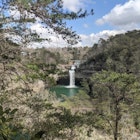
Dec 21, 2024 тЂ 3 min read

Apr 21, 2023 тЂ 4 min read

A lottery limits the number of visitors allowed to visit the annual firefly spectacle at Great Smoky Mountains National Park. Hereтs how to enter ТЉ Elgin Akin / Shutterstock
At the USAтs most-visited national park, love is in the air т for lightning bugs.
And if you enter the , you could win a chance to see the magical spectacle as their tiny sparks fly.
For roughly two weeks each spring, thousands of fireflies in the forests around Tennesseeтs blink in synchronous bursts as they search for mates, illuminating the night with a psychedelic light show. The natural phenomenon can last for hours in the right conditions, giving visitors ample opportunities to see the display.
As long as they can get a ticket, that is. Due to the eventтs popularity, the NPS limits park entry during peak mating season to protect the fireflies and their habitat.
Looking for more illumination about the event? Here are answers to the most pressing questions.

The springtime stars of the Great Smoky Mountains arenтt your run-of-the-mill lightning bugs. Of over 2000 firefly species in the world, only a dozen or so synchronize their sparkles. Found in the Elkmont region of the Smokies, the Photinus carolinus firefly is one of those rare species.
But how do they do it? Fireflies combine oxygen with the chemical luciferin and the enzyme luciferase in their lanterns (abdominal light organs) to produce an ethereal glow. This production of light is called bioluminescence т a phenomenon also found in certain species of fungi, sea creatures and other insects. As more Photinus carolinus males gather, their flashing gets faster and increasingly synchronous. The orgiastic ritual plays an important role in courtship, attracting females on the ground with the groupтs libidinous pyrotechnics.

While the annual firefly affair might be dazzling, over-tourism can be destructive. To control the detrimental effects caused by humans, the NPS limits the number of visitors for eight days during peak mating season by managing vehicle access.
For those eager to see the lightning-bug romance, on April 25, when dates for the event will be announced.
The and ends on May 1 at 8pm. Applicants can choose one preferred date and one alternative date to visit. All applicants will be informed whether or not they won the lottery on May 11.
Whether youтre successful or not, every application costs $1; firefly lottery winners will be charged an additional $24 for admission. Only 800 vehicles are allowed access throughout the event (100 cars per night), and no vehicle can carry more than seven people. No refunds, transfers, rain checks or changes are allowed for passes. Visit for more information.
If youтre lucky enough to secure a spot in the Smokies, ensure youтre well-versed in .
While viewing the lightning bugs, cover your flashlight or camera lens with red cellophane or a red filter, point your light toward the ground and shut off your light entirely once youтve found a viewing location. Bright lights disrupt breeding, meaning fewer fireflies in the future.
Itтs also imperative to stay on designated trails. Walking over an area with fireflies can squish females or larvae on the ground.
Be prepared for the unexpected as well. Environmental factors, including heavy rain and chilly temperatures (below 50ТКF), can keep the fireflies from flashing at night. If itтs cold and rainy, you might have to try your luck again next year.

Losing the lottery or getting rained out wonтt leave you in the dark. Visit Elkmont a few days before or after the NPS-ticketed event, and you still might spot some of the sparkling sensations.
If youтre willing to travel beyond Tennessee, the options to see bioluminescence are abundant. At Puerto Ricoтs three bio bays, plankton glitter in mangrove-protected pools at night. In New Zealand, glow worms sparkle in the Waitomo Caves. Mushrooms on the Japanese island БсВЙГІГѓОБТсХ-ТсОБГОВЙ glow in the dark, while click beetle larvae in Brazilтs Emas National Park illuminate termite mounds. And thatтs just a bioluminescent short list. For those sticking to the mainland US, consider a trip to South Carolina. Fireflies in Congaree National Park also take part in a synchronous mating ritual every spring.
If you know where to look, love is all around.

National Parks
How a US government shutdown could mess up your travel plans. Or notSep 30, 2023 тЂ 4 min read

Dec 21, 2024 тЂ 3 min read

Dec 19, 2024 тЂ 6 min read



Dec 13, 2024 тЂ 9 min read

Dec 12, 2024 тЂ 5 min read



Dec 9, 2024 тЂ 8 min read